Readings Newsletter
Become a Readings Member to make your shopping experience even easier.
Sign in or sign up for free!
You’re not far away from qualifying for FREE standard shipping within Australia
You’ve qualified for FREE standard shipping within Australia
The cart is loading…






This title is printed to order. This book may have been self-published. If so, we cannot guarantee the quality of the content. In the main most books will have gone through the editing process however some may not. We therefore suggest that you be aware of this before ordering this book. If in doubt check either the author or publisher’s details as we are unable to accept any returns unless they are faulty. Please contact us if you have any questions.
Molecular similarity has always been an important conceptual tool of chemists, yet systematic approaches to molecular similarity problems have only recently been recognized as a major contributor to our understanding of molecular properties. Advanced approaches to molecular similarity analysis have their foundation in quantum similarity measures, and are important direct or indirect contributors to some of the predictive theoretical, computational, and also experimental methods of modern chemistry.
This volume provides a survey of the foundations and the contemporary mathematical and computational methodologies of molecular similarity approaches, where special emphasis is given to applications of similarity studies to a range of practical and industrially significant fields, such as pharmaceutical drug design.
The authors of individual chapters are leading experts in various sub-fields of molecular similarity analysis and the related fundamental theoretical chemistry topics, as well as the relevant computational and experimental methodologies. Whereas in each chapter the emphasis is placed on a different area, nevertheless, the overall coverage and the wide scope of the book provides the reader with a general yet sufficiently detailed description that may serve as a good starting point for new studies and applications of molecular similarity approaches.
The editors of this volume are grateful to the authors for their contributions, and hope that the readers will find this book a useful and motivating source of information in the rapidly growing field of molecular similarity analysis.
$9.00 standard shipping within Australia
FREE standard shipping within Australia for orders over $100.00
Express & International shipping calculated at checkout
This title is printed to order. This book may have been self-published. If so, we cannot guarantee the quality of the content. In the main most books will have gone through the editing process however some may not. We therefore suggest that you be aware of this before ordering this book. If in doubt check either the author or publisher’s details as we are unable to accept any returns unless they are faulty. Please contact us if you have any questions.
Molecular similarity has always been an important conceptual tool of chemists, yet systematic approaches to molecular similarity problems have only recently been recognized as a major contributor to our understanding of molecular properties. Advanced approaches to molecular similarity analysis have their foundation in quantum similarity measures, and are important direct or indirect contributors to some of the predictive theoretical, computational, and also experimental methods of modern chemistry.
This volume provides a survey of the foundations and the contemporary mathematical and computational methodologies of molecular similarity approaches, where special emphasis is given to applications of similarity studies to a range of practical and industrially significant fields, such as pharmaceutical drug design.
The authors of individual chapters are leading experts in various sub-fields of molecular similarity analysis and the related fundamental theoretical chemistry topics, as well as the relevant computational and experimental methodologies. Whereas in each chapter the emphasis is placed on a different area, nevertheless, the overall coverage and the wide scope of the book provides the reader with a general yet sufficiently detailed description that may serve as a good starting point for new studies and applications of molecular similarity approaches.
The editors of this volume are grateful to the authors for their contributions, and hope that the readers will find this book a useful and motivating source of information in the rapidly growing field of molecular similarity analysis.